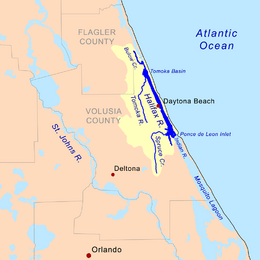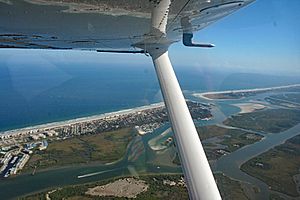Halifax River facts for kids
Quick facts for kids Halifax River |
|
|---|---|

A view of the Halifax River southbound from the Seabreeze Bridge, Daytona Beach, Volusia County, Florida. Three other bridges can be seen from this vista: Main Street Bridge (closest), Broadway Bridge, and Veterans Memorial Bridge. Two boat marinas can be seen to the right.
|
|

Halifax River Drainage Basin
|
|
| Country | United States |
| State | Florida |
| Cities | Ormond Beach, FL, Holly Hill, FL, Daytona Beach, FL, South Daytona, FL, Port Orange, FL |
| Physical characteristics | |
| Main source | Tomoka Basin Tomoka State Park, Volusia County, FL 5 ft (1.5 m) 29°21′40″N 81°05′30″W / 29.36111°N 81.09167°W |
| River mouth | Atlantic Ocean Ponce Inlet, Volusia County, FL 0 ft (0 m) 29°04′25″N 80°55′22″W / 29.07361°N 80.92278°W |
| Length | 25 mi (40 km) |
| Basin features | |
| Basin size | 1,009 sq mi (2,610 km2) |
| Tributaries |
|
The Halifax River is a beautiful waterway in northeast Volusia County, Florida, in the United States. It's part of the larger Atlantic Intracoastal Waterway, which is like a long water highway along the coast. The river was first called the North Mosquito River. But during the time when the British controlled Florida (from 1763 to 1784), it was renamed after George Montagu-Dunk, 2nd Earl of Halifax.
Contents
Exploring the Halifax River's Geography
The Halifax River starts at Tomoka Bay. This is where the Tomoka River, Bulow Creek, and Halifax Creek all meet, close to Tomoka State Park. The river's drainage basin (think of it as the area of land where all the rain and water flow into the river) covers most of eastern Volusia County. This includes water from the Tomoka River and Halifax Creek. The total area is about 1,008 square kilometers (389 square miles).
The Halifax River flows south for about 25 miles (40 kilometers). It eventually joins with Spruce Creek and the Mosquito Lagoon. From there, it connects to the Atlantic Ocean through the Ponce de Leon Inlet.
The river flows through or near several cities, including Ormond Beach and Daytona Beach. You can also spot famous landmarks along its banks, like the Jackie Robinson Ballpark on City Island and the Ponce de Leon Inlet Lighthouse. The Halifax Harbor Marina is also located on this waterway.
Cities Along the River's Path
The Halifax River is important to many cities in the area. It even helped define some of their borders! The middle of the river often marked the line between different cities. Here are some of the cities connected to the Halifax River, listed from north to south:
- Ormond Beach - This city was named after James Ormond, an early settler who arrived in 1807. It became a town in 1880.
- Holly Hill - Located north of Daytona Beach, this city was settled around 1876. Its founder, William Samuel Fleming Sr., named it in 1901 because it reminded him of his home in Ireland.
- Daytona Beach - Named after Mathias Day from Ohio, who bought land here in 1870. The town of Daytona was created in 1876. Later, in 1926, several smaller towns like Daytona, Daytona Beach, Kingston, and Seabreeze joined together to form the Daytona Beach we know today.
- South Daytona - This area was first known as Blake and was settled around 1886. It became its own city in 1938, taking the name South Daytona to honor Mathias Day.
- Daytona Beach Shores - This newer community is on the beach side, south of Daytona Beach. It was formed in 1960 by a group of hotel owners and became a city in 1967. Locals often call it "The Shores."
- Port Orange
- Ponce Inlet

Bridges Connecting the Shores
There are six bridges that cross the Halifax River, connecting the mainland to the beachside. Some of these are bascule bridges, which means they can open up to let boats pass through. They are listed from north to south:
- Granada Bridge (SR 40) - The first bridge here opened in 1887. The current high bridge was built in 1983.
- Seabreeze Bridge (SR 430) - The first Seabreeze Bridge was built in 1902. Today, there are two high bridges that replaced an older drawbridge in 1997.
- Main Street Bridge (CR 4040) - The first bridge at this spot opened in 1888. A new bascule bridge was built in 1959.
- Broadway Bridge (US 92) - The first bridge here was built in 1912. A new, taller bridge opened in 2001. This bridge is famous for its cool mosaics of manatees and dolphins!
- Veterans Memorial Bridge (CR 4050) - This bridge was first built in 1899. A replacement was built in 1954 and renamed the Veterans Memorial Bridge in 1959. It is currently being replaced with a new, tall bridge.
- Port Orange Causeway (SR A1A) - Also called the Port Orange Bridge or Dunlawton Avenue Bridge. The first bridge here was built in 1906. The current high bridge was built in 1990.
A Look Back: History of the Halifax River
First People: Native Americans
People have lived around the Halifax River for about 7,000 years! The first residents were Native American tribes, including ancestors of the Timucua Indians. They lived by fishing and eating oysters, leaving behind large shell mounds. While many of these mounds were used by later settlers to build roads, some still exist today as historical sites. These include Green Mound, Nocoroco, Ormond Mound, and Spruce Creek Mound Complex.
European Explorers Arrive
Spanish Explorers (1513-1763)
After Juan Ponce de León claimed Florida in 1513, and Pedro Menéndez de Avilés founded St. Augustine in 1565, the Spanish continued to explore. In 1569, Captain Antonio de Prado explored the area around Ponce de Leon Inlet. He called it los Mosquitos because of all the gnats! In 1605, Spanish explorer Alvaro Mexia mapped the Halifax River area, calling it the North Mosquito River. He noted Native American villages like Nocoroco and Cicale.
The Spanish also brought Franciscan friars to set up Catholic Missions. They wanted to convert the native people to Christianity. At one point, there were 44 such Spanish missions in Florida. However, diseases like yellow fever, smallpox, and measles greatly reduced both the Native American and Spanish populations. By 1763, when Spain gave Florida to the British, the area was almost empty.
British Rule (1763-1783)
Spain gave Florida to the British in 1763 after a war. Britain then divided Florida into two parts. They offered land grants to encourage people to settle there. During this time, the Halifax River got its name, honoring Lord Halifax, a British leader. Many colonists from other parts of America moved to Florida, especially during the American Revolution. They even named a colony near present-day Port Orange Halifax City.
During British rule, Dr. Andrew Turnbull started a colony called New Smyrna just south of the Halifax River in 1768. The colonists there faced harsh conditions, but eventually, the British Governor allowed them to leave.
Spanish Rule Returns (1783-1821)
After the American Revolution, Britain gave Florida back to Spain in 1783. Spain allowed British colonists to stay if they promised loyalty to Spain and became Catholic.
During this time, Spain gave out large land grants in the Halifax River area. One went to James Ormond, a Scottish sea captain, in 1807. He received 2,000 acres for transporting friars for the Spanish. Other grants for areas like Daytona Beach and Port Orange went to owners who didn't live there, so those areas didn't develop much at first.
Fun on the Halifax River: Recreation
Boating Adventures
Boating is a very popular activity on the Halifax River! There are many marinas and yacht clubs along the river where people can dock their boats. The Halifax River Yacht Club, for example, has been around since 1896!
Fishing Fun
Fishing is another favorite pastime on the Halifax River. You can fish from boats, from the riverbanks, or even from the bridges that cross the water. Some of the fish you might catch include:
Spotting Wildlife
The Halifax River is home to many different kinds of animals. You can see various waterfowl (birds that live on water), wading birds (birds with long legs for walking in shallow water), fish, and other creatures. The river and some of its smaller streams are even special sanctuaries for manatees!
Other rare animals that live in the river basin include the wood stork, bald eagle, and the Atlantic salt marsh snake. Many other birds can be seen all around the Halifax River area.
The Halifax River Trail is also part of the East Coast Greenway. This is a huge system of trails that connects Maine all the way to Florida!
The Intracoastal Waterway's Importance
Before 1913, private companies mostly managed navigation channels and canals in Florida. In 1882, a company was formed to create a waterway from Jacksonville to Biscayne Bay. They did this by connecting rivers and lagoons with canals, including the Halifax River. This huge project was finished in 1908.
In 1927, the U.S. Congress approved the Atlantic Intracoastal Waterway. This waterway became very important during World War II. German submarines were sinking many ships off the East Coast, so the Intracoastal Waterway provided a safer route for boats. The U.S. Army Corps of Engineers still takes care of the navigation channel today, keeping it clear for boats.
Images for kids









